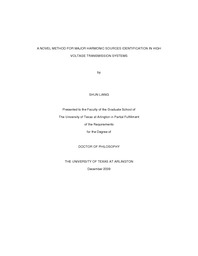| dc.description.abstract | Due to the proliferation of high-voltage power electronics devices and nonlinear loads connected to power systems, the penetration of produced harmonics into power transmission networks to pollute power quality of power systems has been a new concern. Recently, an electric utility company in Texas has observed that harmonic levels may exceed the recommended levels of IEEE Std. 519-1992 at some points in the 138 kV, 161 kV, and 345 kV transmission systems. In order to meet the requirement of the IEEE recommended practice and maintain the power quality of electricity delivered to consumers, identification of major harmonic sources to mitigate harmonic problems by using proper countermeasure is one of the most important tasks of electric utility companies. In this research work, before applying any harmonic sources identification algorithms, the accuracy of the harmonic component measurement equipments used in this transmission network is verified. The verification effort mainly focuses on two types of Coupling Capacitor Voltage Transformers (CCVTs). Frequency response simulations were conducted to obtain the harmonic measurement adjustment values for these two types of CCVTs. The field tests were carried out to verify the validity of the simulation results. After the harmonic measurement accuracy is verified, the harmonic characteristics observed in the example transmission system are presented. Because of the harmonic characteristics, it was found that traditional methods for identifying harmonic sources can not be applied effectively in the sample high voltage transmission system due to limited measurement locations. Besides, unbalanced harmonic voltages and harmonic resonance also increase the complexity to the harmonic sources identification problems. To overcome these difficulties, this dissertation develops a novel two-step method to identify major harmonic sources in high voltage transmission networks using harmonic phase-sequence components, a sub-transmission network extraction scheme, and a harmonic impedance matrix. Based on the proposed harmonic source identification method, a software package was developed, which is named Harmonic Source Identification Software (HSIS). HSIS performs harmonic source identification for high voltage transmission systems. It reads Microsoft Excel files as prepared input data, and calculates possible harmonic sources. The identified possible harmonic sources are stored in an output file. The detailed information about HSIS is also introduced in this dissertation.Numerical simulations on the IEEE 300-bus system are performed to examine the effectiveness of the proposed method. The simulation results show that the proposed scheme can effectively identify the major harmonic sources with limited harmonic measurement points even with unbalanced harmonic voltages and measurement noises exist in the studied system. | en_US |

